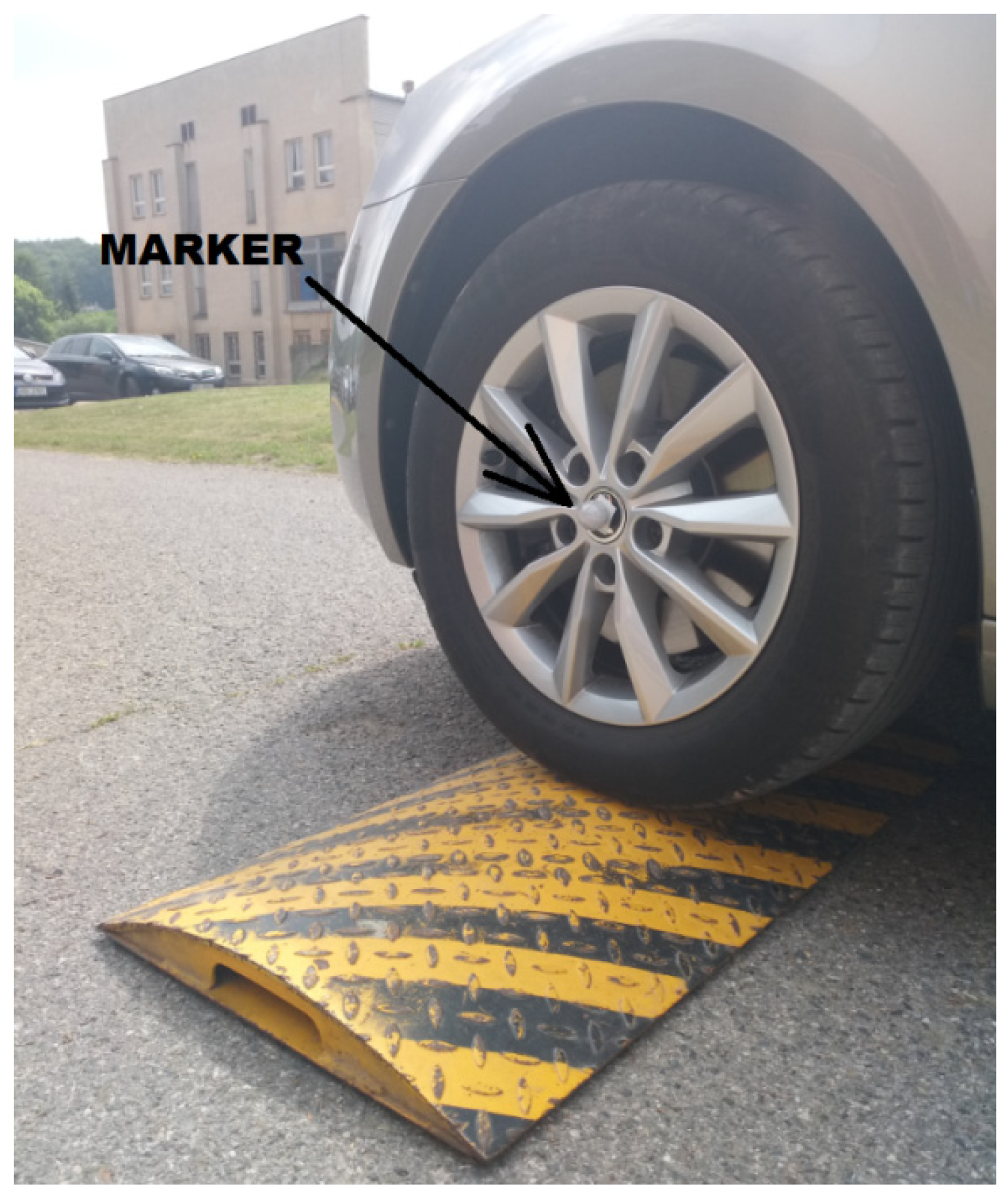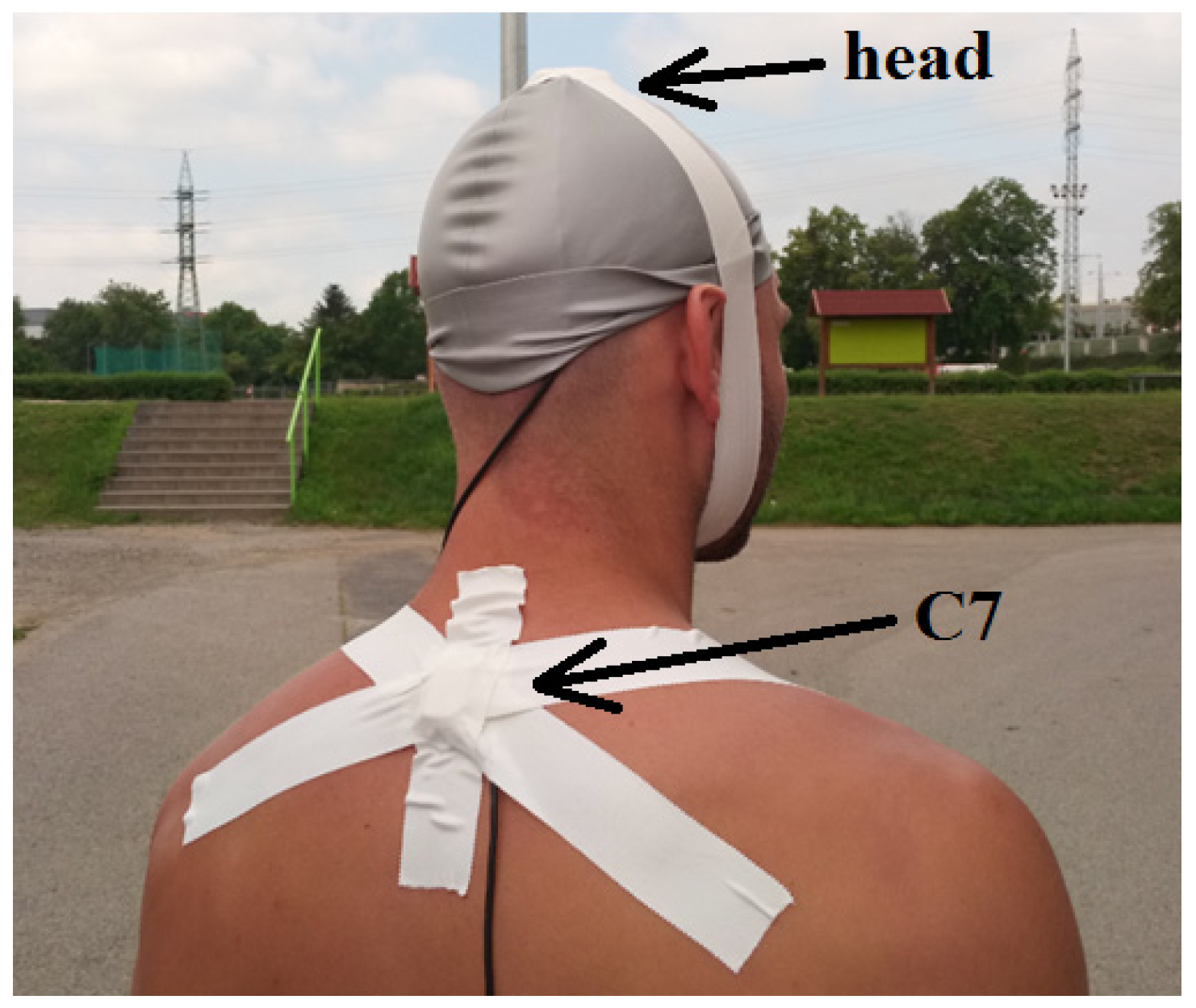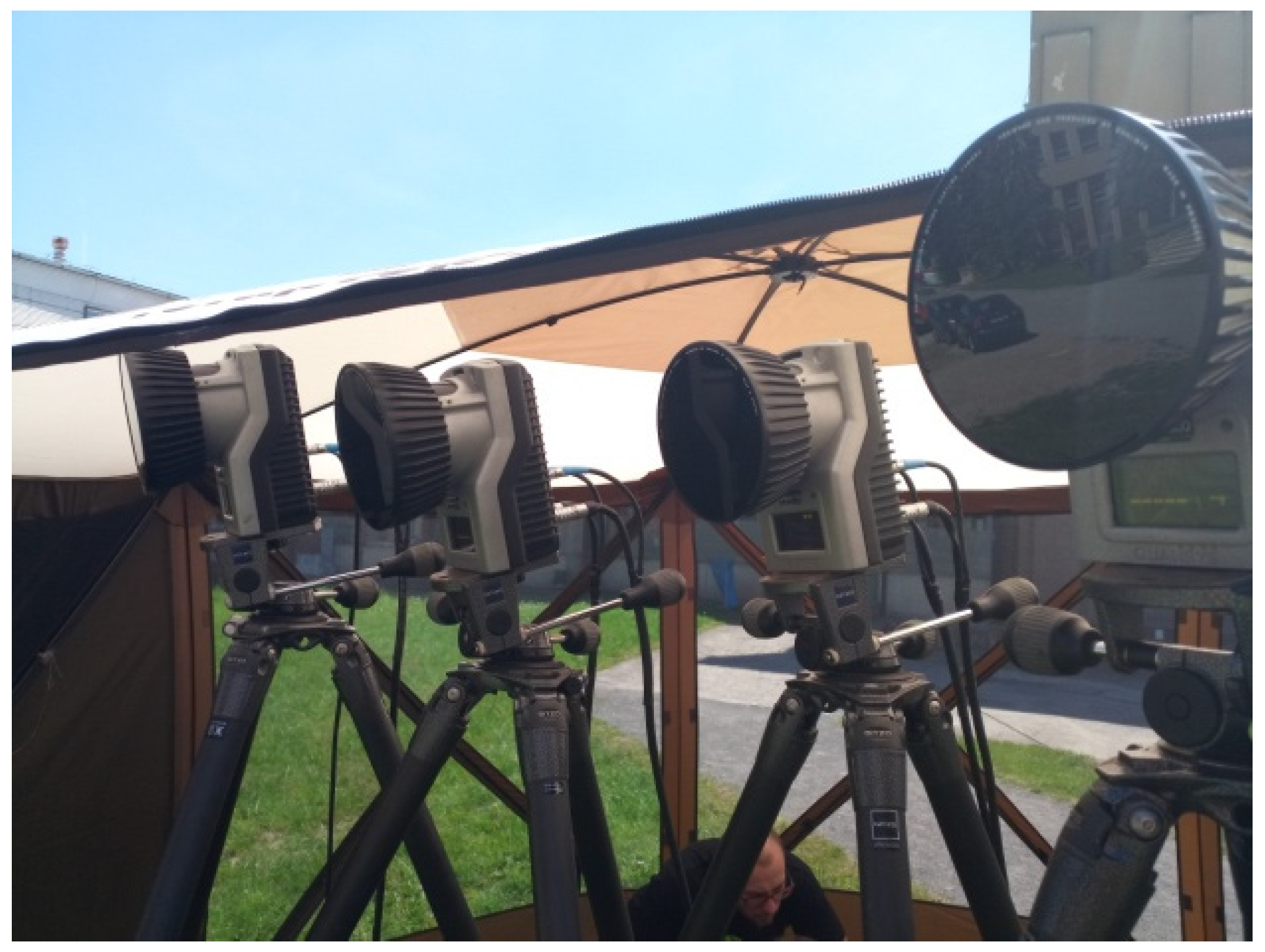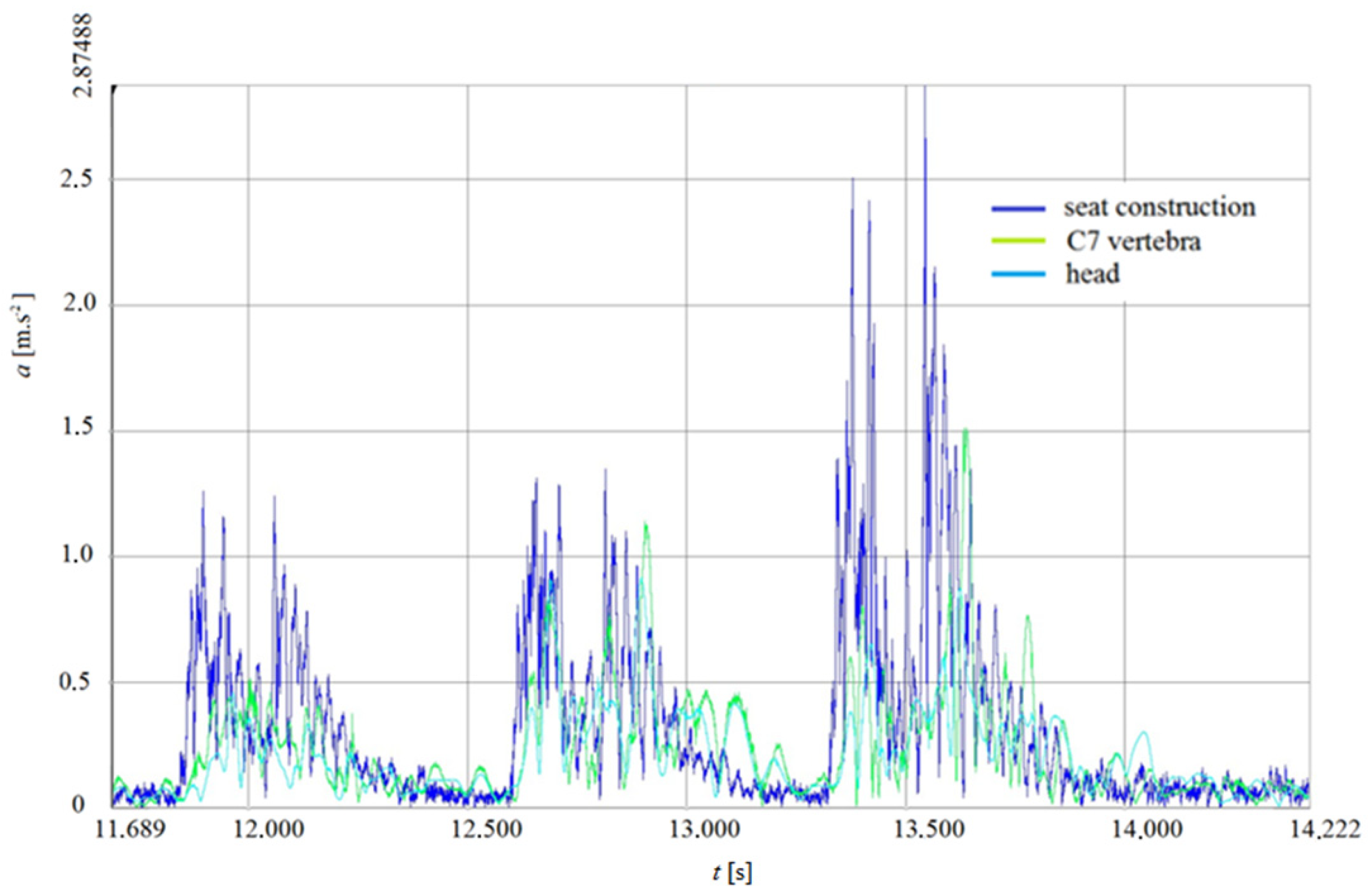Load Measurement of the Cervical Vertebra C7 and the Head of Passengers of a Car While Driving across Uneven Terrain
Abstract
:1. Introduction
| • car | 0.20–0.75 m.s−2 |
| • bus | 0.40–0.80 m.s−2 |
| • tractor | 0.40–2.80 m.s−2 |
| • forklift | 0.40–2.00 m.s−2 |
| • locomotive | 0.30–0.60 m.s−2 |
| • tank | 1.50–3.50 m.s−2 |
| • ship | 0.50–0.70 m.s−2 |
| • helicopter | 0.10–1.55 m.s−2 |
2. Experimental Solution
- 3x triaxial accelerometer MMF KS 943B.100 (10 mV/m.s−2)—placed on the head and vertebra C7;
- 1x triaxial accelerometer MMF KS 943B.10 (1 mV/m.s−2)—located on the car seat frame under the seat;
- 2x uniaxial accelerometer SMS MH 118 (1 pC/m.s−2)—located between the buttocks and the seat and on the wheel suspension.
3. Measurements Results
4. Conclusions
Author Contributions
Funding
Institutional Review Board Statement
Informed Consent Statement
Conflicts of Interest
References
- Dylevský, I. Funkční Anatomie—1. Vyd; Grada: Praha, Czech Republic, 2009; p. 544. ISBN 978-80-247-3240-4. [Google Scholar]
- Battaglia, G.; Giustino, V.; Iovane, A.; Bellafiore, M.; Martines, F.; Patti, A.; Palma, A. Influence of occlusal vertical dimension on cervical spine mobility in sports. Acta Med. 2016, 32, 1589. [Google Scholar]
- Rubin, C.; Pope, M.; Fritton, J.C.; Magnusson, M.; Hansson, T.; Mcleod, K. Transmissibility of 15-Hertz to 35-Hertz Vibrations to the Human Hip and Lumbar Spine: Determining the Physiologic Feasibility of Delivering Low-Level Anabolic Mechanical Stimuli to Skeletal Regionsat Greatest Risk of Fracture Because of Osteoporosis. Spine 2008, 28. [Google Scholar] [CrossRef] [PubMed] [Green Version]
- Jandák, Z. Vibrace Přenášené na Člověka. State Health Institute. 2007. Available online: http://www.szu.cz/tema/pracovni-prostredi/vibrace-prenasene-nacloveka (accessed on 4 January 2021).
- Hrubý, J.; Krobot, Z. Hodnocení zraňujícího účinku volně uložených předmětů ve vozidle při dopravní nehodě. Úrazová Chir. 2018, 2018, 116–135. [Google Scholar]
- Hnízdil, J. Bolesti Zad Jako Životní Realita: Jejich Příčiny, Diagnostika, Terapie, a Prevence; Triton: Praha, Czech Republic, 2000; p. 167. ISBN 80-7254-098-X. [Google Scholar]
- Fritz, M. Description of the Relation between the Forces Acting in the Lumbar Spine and Whole-Body Vibrations by Means of Transfer Functions. Clin. Biomech. 2000, 15, 234–240. [Google Scholar] [CrossRef]
- Bovenzi, M.; Pinto, I.; Stacchini, N. Low back pain in port machinerry operators. J. Sound Vib. 2002, 253, 3–20. [Google Scholar] [CrossRef]
- Kumar, A.; Varghese, M.; Mohan, D.; Mahajan, P.; Gulati, P.; Kale, S. Effect of whole-body vibration on the low back. A study of tractor-driving farmers in north India. Spine 1999, 24, 2506–2515. [Google Scholar] [CrossRef] [PubMed]
- Alperowitch-Najenson, D.; Santo, Y.; Masharawi, Y.; Katz-Leurer, D. Low Back Pain among Professional Bus Drivers: Ergonomic and Occupational-Psychosocial Risk Factors. Israel Med. Assoc. J. 2010, 12, 26–31. [Google Scholar]
- Robb, M.J.; Mansfield, N.J. Self-reported musculoskeletal problems amonit professional truck drivers. Ergonomics 2007, 50, 814–827. [Google Scholar] [CrossRef] [PubMed]
- Netterstron, B.; Juel, K. Low back trouble among urban bus drivers in Denmark. Scand. J. Soc. Med. 1989, 17, 203–206. [Google Scholar] [CrossRef] [PubMed]
- Donnelly, C.J.; Callghan, J.P.; Durkin, J.L. The Effect of an Active Lumbar System on the Seating Comfort of Officers in Police Fleet Vehicles. Int. J. Occup. Saf. Ergon. 2009, 3, 295–307. [Google Scholar] [CrossRef] [PubMed] [Green Version]
- Chen, J.-C.; Dennerlein, J.; Chang, C.C.; Chang, W.; Christiani, D.C. Seat inclination, use of lumbar support and low-back pain of taxi drivers. Scand. J. Work Environ. Health 2005, 258–265. [Google Scholar] [CrossRef] [PubMed] [Green Version]
- Ravnik, D. Vliv vibrací na lokální hemodynamiku krve. In Komplexita Biomateriálů a Tkáňových Struktur; Univerzita Karlova, Fakulta Tělesné Výchovy a Sportu: Praha, Czech Republic, 2002; ISBN 80-86317-20-X. [Google Scholar]
- Krobot, Z.; Hrubý, J.; Neumann, V.; Túró, T. The Injurious Effects of Freely Transported Objects on a Crew in Military Vehicles during Traffic Acidents. In Proceedings of the ICMT 2019—7th International Conference on Military Technologies, Brno, Czech Republic, 30–31 May 2019; University of Defence: Brno, Czech Republic, 2019; p. 8870080, ISBN 978-172814593-8. [Google Scholar]
- Kajiwara, Y.; Kimura, H. Predicting the Coping Skills of Older Drivers in the Face of Unexpected Situation. Sensors 2021, 21, 2099. [Google Scholar] [CrossRef] [PubMed]
- Černohlávek, V.; Svoboda, M.; Štěrba, J.; Chalupa, M.; Sapieta, M. Analytical and experimental solution of vibrations of a system of bound bodies. Manuf. Technol. 2020, 20, 699–707. [Google Scholar] [CrossRef]
- Pelclová, D.; Lebedová, J.; Fenclová, Z.; Lukáš, E. Nemoci z Povolání a Intoxikace; Karolinum: Praha, Czech Republic, 2006; ISBN 80-246-1183-X. [Google Scholar]
- Harrison, D.D.; Harrison, S.O.; Arthur, A.; Croft, C. Sitting Biomechanics, Part I1: Optimal Car Driver’s Seat and Optimal Driver’s Spinal Model: Review of the literature. J. Manip. Physiol. Ther. 2000, 23, 37–47. [Google Scholar] [CrossRef]
- Zhao, Y.; Wang, X. A Review of Low-Frequency Active Vibration Control of Seat suspension Systems. Appl. Sci. 2019, 9, 3326. [Google Scholar] [CrossRef] [Green Version]
- Quoc, M.; Krzikala, D.; Mesicek, J.; Petru, J.; Smiraus, J.; Sliva, A.; Poruba, Z. On Aluminum Honeycomb Impact Attenuator Designs for Formula Student Competitions. Symmetry 2020, 12, 1647. [Google Scholar] [CrossRef]
- Peng, Q.; Xu, P.; Yuan, H.; Ma, H.; Xue, J.; He, Z.; Li, S. Analysis of Vibration Monitoring Data of Flexible Suspension Lifting Structure Based on Time-Varying Theory. Sensors 2020, 20, 6586. [Google Scholar] [CrossRef] [PubMed]
- Svoboda, M.; Chalupa, M.; Jelen, K.; Kubový, P.; Sapieta, M. Loading of the Musculoskeletal System of a Person While Driving in a Passenger Car. ECS Trans. 2019, 95, 449–456. [Google Scholar] [CrossRef]
- Lehnen, N.C.; Haase, R.; Faber, J.; Rüber, T.; Vatter, H.; Radbruch, A.; Schmeel, F.C. Detection of Degenerative Changes on MR Images of the Lumbar Spine with a Convolutional Neural Network: A Feasibility Study. Diagnostics 2021, 11, 902. [Google Scholar] [CrossRef]
- Zhang, X.; Xu, X.; Wang, J.; Wang, C.; Yan, Y.; Wu, A.; Ren, Y. Public-Health-Driven Microfluidic Technologies: From Separation to Detection. Micromachines 2021, 12, 391. [Google Scholar] [CrossRef] [PubMed]










| Speed | 10 km.h−1 | 20 km.h−1 | 30 km.h−1 | 40 km.h−1 | 50 km.h−1 |
|---|---|---|---|---|---|
| Driver-human | V1–V7 | V8–V14 | V15–V21 | V22–V28 | V29–V35 |
| Co-driver-human | V36–V42 | V43–V49 | V50–V56 | V57–V63 | V64–V70 |
| Velocity [km.hod−1] | Measured Acceleration Values | |||
|---|---|---|---|---|
| Seat Construction [m.s−2] | Under the Buttock [m.s−2] | C7 [m.s−2] | Head [m.s−2] | |
| 10 | 1.556 | 1.304 | 0.499 | 0.407 |
| 20 | 1.805 | 1.514 | 0.775 | 0.604 |
| 30 | 2.350 | 2.147 | 1.351 | 1.109 |
| 40 | 3.178 | 2.199 | 1.490 | 1.179 |
| 50 | 2.875 | 2.755 | 1.516 | 1.316 |
| Velocity [km.hod−1] | Measured Acceleration Values | |||
|---|---|---|---|---|
| Seat Construction [m.s−2] | Under the Buttock [m.s−2] | C7 [m.s−2] | Head [m.s−2] | |
| 10 | 1.156 | 0.853 | 0.784 | 0.671 |
| 20 | 2.049 | 1.633 | 1.131 | 0.772 |
| 30 | 2.542 | 1.695 | 1.255 | 0.965 |
| 40 | 3.608 | 2.471 | 1.465 | 1.245 |
| 50 | 3.786 | 2.413 | 1.624 | 1.153 |
| Velocity [km.hod−1] | C7 | HEAD | ||
|---|---|---|---|---|
| Max. Acceleration [m.s−2] | Standard Deviation | Max. Acceleration [m.s−2] | Standard Deviation | |
| 30 | 1.201 | 0.232 | 1.199 | 0.016 |
| 30 | 0.786 | 0.183 | 0.825 | 0.150 |
| 30 | 0.955 | 0.014 | 1.131 | 0.371 |
| 30 | 0.922 | 0.047 | 0.953 | 0.028 |
| 30 | 0.839 | 0.032 | 0.788 | 0.262 |
| 30 | 1.080 | 0.111 | 0.958 | 0.176 |
| 30 | 1.001 | 0.130 | 0.899 | 0.241 |
| Average value | 0.969 | 0.017 | 0.965 | 0.020 |
Publisher’s Note: MDPI stays neutral with regard to jurisdictional claims in published maps and institutional affiliations. |
© 2021 by the authors. Licensee MDPI, Basel, Switzerland. This article is an open access article distributed under the terms and conditions of the Creative Commons Attribution (CC BY) license (https://creativecommons.org/licenses/by/4.0/).
Share and Cite
Svoboda, M.; Chalupa, M.; Jelen, K.; Lopot, F.; Kubový, P.; Sapieta, M.; Krobot, Z.; Suszyński, M. Load Measurement of the Cervical Vertebra C7 and the Head of Passengers of a Car While Driving across Uneven Terrain. Sensors 2021, 21, 3849. https://doi.org/10.3390/s21113849
Svoboda M, Chalupa M, Jelen K, Lopot F, Kubový P, Sapieta M, Krobot Z, Suszyński M. Load Measurement of the Cervical Vertebra C7 and the Head of Passengers of a Car While Driving across Uneven Terrain. Sensors. 2021; 21(11):3849. https://doi.org/10.3390/s21113849
Chicago/Turabian StyleSvoboda, Martin, Milan Chalupa, Karel Jelen, František Lopot, Petr Kubový, Milan Sapieta, Zdeněk Krobot, and Marcin Suszyński. 2021. "Load Measurement of the Cervical Vertebra C7 and the Head of Passengers of a Car While Driving across Uneven Terrain" Sensors 21, no. 11: 3849. https://doi.org/10.3390/s21113849
APA StyleSvoboda, M., Chalupa, M., Jelen, K., Lopot, F., Kubový, P., Sapieta, M., Krobot, Z., & Suszyński, M. (2021). Load Measurement of the Cervical Vertebra C7 and the Head of Passengers of a Car While Driving across Uneven Terrain. Sensors, 21(11), 3849. https://doi.org/10.3390/s21113849







